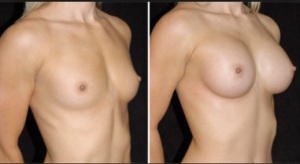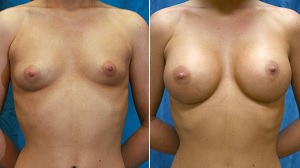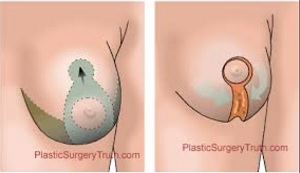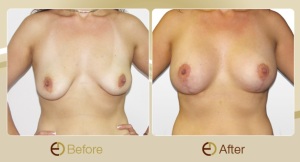Breast implants
Breast implants are prostheses that alter the appearance of a woman’s size in terms of size, shape, texture and form. The  terms breasts augmentation, breast enlargement or augmentation mammaplasty are use to refer to the same thing. This surgical procedure is undertaken for aesthetic purposes.
terms breasts augmentation, breast enlargement or augmentation mammaplasty are use to refer to the same thing. This surgical procedure is undertaken for aesthetic purposes.
Types of breast implants
Breast implants come in various types. These include smooth breast implants, silicone breast implants, saline breast implants, round breast implants, textured breast implants and anatomical.
ALSO READ: Thinking about getting a breasts surgery done? Learn more about the Breast implants cost, procedure and types
History of breast implants
A look back in history shows that breast implants date back in the late nineteenth century. During that time, breast implants were used to better the shape, size, texture and volume of breasts. The earliest recorded case of breast implants is credited to Vincez Czeny in 1895. He is said to have performed the first breast implant. Six years earlier, another surgeon by the name Robert Gersuny had performed a botched breast implants using paraffin injections. It was not until the twentieth century that physicians started using breast implants such as gel.
Why breast implants?
There were various reasons why breast implants were performed. From the psychological point of view, women who had breast implants done on them were in distress. They suffered from low self esteem. There were reported cases of suicide, depression among other mental disorders in women who had not had breast implants done on them. Conversely, those who had breast implants reported improved mental wellbeing, increased sexual satisfaction and a general sense of sexual satisfaction. Inference can be made here that the appearance of breasts was central to their sexuality.
Related: View and discover the recommended breast implant surgeon in Parramatta and ask your questions that you may have
Nothing much has changed since these operations started to date. Most women clamour for attractive breasts. They want to have firm, proportional breasts in shape, size, texture and volume. They want to identify with the glamorous women in glossy magazines and the silver screens. Others want to retain a young figure without the interference from protruding breasts that are sagging, too big or too small.
Objectives of Breast Implants
- The main cause of breast implants is to reconstruct breasts that have been damaged either through cancer, deformity or a traumatizing situation.
- Secondly, breast implants are performed to correct an anomaly from a previous surgery that may not have materialized as expected. This is normally called reconstructive surgery.
- This is usually done purely for cosmetic reasons and has got nothing to do with the condition of the breasts. Women with financial means seek to add aesthetic to their breasts in terms of feel, size and shape.
Surgical Incisions
The first one is known as inframammary. This so called as the incision is done in the infra-mammary fold (IMF). It is the surgical procedure of choice for silicone-gel implants, albeit with noticeable scars.
Periareolar on the other hand is done around the areola. It is mostly performed when there is need for breast lift or adjustment to the inframammary procedure.
Transaxillary procedure is done in the armpit. This is usually done to avoid scars, though it generally has to be followed by either of the two above procedures due to the inferior results resulting thereto.
Tran umbilical incision, also known as trans-umbilical breast augmentation (TUBA) done on the navel heading upwards to the bust region. This one is not common.
Lastly, there is transabdominal incision involving the abdomen. The procedure is known as the transabdominoplasty breast augmentation (TABA).
Recovering From Breast Enlargement Surgery
Breast Enlargement or breast augmentation recovery is an important phase after the surgery. The surgical procedure may be  short (usually 1-2 hours) and you may be discharged same day or the following day. The recovery journey is a bit long. After the surgery in which implants are placed in the breast pockets, the breasts are swathed in gauze dressings as well as a bra to hold them in place. This allows healing to commence.
short (usually 1-2 hours) and you may be discharged same day or the following day. The recovery journey is a bit long. After the surgery in which implants are placed in the breast pockets, the breasts are swathed in gauze dressings as well as a bra to hold them in place. This allows healing to commence.
As you begin recovery journey back home, there are a number of things that you need to bear in mind to hasten the healing process.
Post surgery Pain
This is expected. You will, after operation, have some breast swelling accompanied by tightness around the chest area. The surgeon may recommend you stay put in a slanted position so as to suppress the swelling. If this swelling does not abate, then you may be dispensed some pain killers. The breasts may also be hard to feel some sharp twitches of pain. These should recede as you progress with recovery. A word of caution though, if you are asthmatic, or has body organ problems such as liver and kidneys, then you should avoid taking medications such as ibuprofen as this may aggravate your condition.
Breasts Support
Incisions can be source of infection if not treated with care. Your surgeon will ask you to use a support bra as well as use ointment on the incisions to enhance healing. Your surgeon will direct you on how to go about it.
Normal Routine
You may proceed with your daily routines such as exercises, job and household duties as directed by your surgeon or physician. The point is that you should not strain especially with the arms and the upper body parts due to possibility of opening up the stitches to bleeding. Rest is paramount if you are to make quick recovery.
Post-operative visits
Over and above the home care for the enlarged breasts, you may be required so that the enlarged breasts may be checked.
Breast enlargement Details
Nothing is taken for granted after breast enlargement. It is important to take down some vital information regarding your breasts. In particular, you need to take note the name of the manufacturer of the implants. Also take cognizant of the style and serial number printed on the breast implant. Lastly, you may also note the batch number. These details are important especially in case the breast implant after enlargement develop complications.
Tell-tale signs to watch out after Breast Enlargement
Although we have noted some expected pains and discomfort immediately after the procedure, you should watch out for more severe ones that may require re-admission for medical treatment. Please check in back to hospital in case of severe breast pain accompanied by redness of the breasts. Sometimes the swelling may be more than ordinarily expected or a smelly discharge from the incisions. This is an indication of an infection and should be given the surgeon’s attention as soon as possible. Watch out too for lumps in the breasts as well as increased body temperature.

Breast Reduction
Breast reduction or reduction mammaplasty is a surgical procedure that helps not only to reduce the size of the breasts but also in giving them shape and form.
How Breast Reduction is Done-overview
This procedure is done in hospital under either general anesthesia or a local one, depending on the extent of the work to be done on your breasts. The procedure takes on average of 3-5 hours. In extreme cases, you may stay for a night, although this is generally an outpatient procedure. The surgeon removes extra tissue on your breasts by making incisions. After that, the tissue is removed followed by sewing back the skin. The areola and nipple may also be operated with aim of positioning or aligning them.
done on your breasts. The procedure takes on average of 3-5 hours. In extreme cases, you may stay for a night, although this is generally an outpatient procedure. The surgeon removes extra tissue on your breasts by making incisions. After that, the tissue is removed followed by sewing back the skin. The areola and nipple may also be operated with aim of positioning or aligning them.
ALSO READ: More breast implants reviews here and get that great looking breasts today!
Why is Breast Reduction Done?
The whole aim of breast reduction is help you be more comfortable within yourself. No one wants to move around with weighty breasts that only adds agonizing neck and back pain. No one wants to experience skin irritation and problems with posture. Equally, no woman wants to have dents on their shoulders occasioned by the pressure exerted by straps.
How is Breast Reduction Different from Breast Lift?
Many people tend to confuse these two surgical procedures. They may have some similarities with the only difference being the fact that while breast lift actually ‘lifts’ the breasts that are heavy and sagging, breast reduction aims at removing the extra tissue on your breasts so as to reduce the size.
Breast Reduction Results
After the 3-5 hours surgical process, your breasts will bandaged after placing a gauze over the cut areas. You may also have a specially designed support bra in place (some surgeons recommend use of support bra, others don’t).
Accumulation of fluid or blood is common after this kind of surgery, so the surgeon may insert a tube under the tissues to drive out such fluids. If this is not done, the accumulation of the fluids may cause serious complications.
In regard to your stitches, these are given up to 14 days after which you should return to hospital to have them removed. The stitch marks do not disappear immediately, though they do eventually fade away.
Pain is a common experience and should be expected but recedes as time passes by. In case of severe pain, you may be given some pain killers. Other problems you may see on your breasts include bruising and swelling which may remain for a few weeks and then go away. To aid in reducing the swelling, you may be advised to put on the support bra all the time.
Resumption of duty may have to wait a little longer-at least 4 weeks after the surgery. You need to understand that any strenuous activity like lifting heavy objects, jogging or running may affect the healing process. You may, on the leave of the doctor, carry out some simple house chores in a few weeks after leaving the hospital.
Some surgical scars or scaring remain an enduring mark of the surgery process. They may be covered by the bra or while swimming, a swim suit. Unfortunately, some scars do not completely disappear over time, so you may learn to live with them.
RELATED: If you are looking for a breast implants surgeon in Sydney, visit- http://www.sydneycosmeticspecialists.com.au/breast-implants/. Explore your options to see which techniques and breast implants types are good for you.
Breast lift Procedure
Once you have undergone a breast lift procedure, the next phase involves recovery from the plastic surgery. At this point and  time, you will have bandages or dressings on the incision sites. Some surgeons will also recommend you to wear a support bra and have a tube inserted under your skin to help remove any accumulation of blood or fluid (hematoma).
time, you will have bandages or dressings on the incision sites. Some surgeons will also recommend you to wear a support bra and have a tube inserted under your skin to help remove any accumulation of blood or fluid (hematoma).
Post-Surgical care of Breasts
You surgeon will provide you with information on how to take care of breasts to avoid complications as well as to hasten the healing process. You will also be administered some, either for swallowing or ointment to rub on the incision areas. These medications will help relieve you from any pain that you may experience as well as help prevent physical symptoms such as swelling. The antibiotics the surgeon will give you will help prevent in infection that may result thereafter. It is advisable to follow the medication as prescribed and report any side effects that you experience on their use.
Over and above the home care that you may receive from your extended family, the surgeon will give you appointment dates for a follow up on the healing process. Should you however develop any complications before due date with your surgeon-for instance reddening in the breast area, it is imperative you ring your doctor and make an impromptu visit.
What to Expect: Questions you should ask your Surgeon
Before leaving the surgeon room, have in mind some questions ready to ask the surgeon regarding the operation. Most patients are unsure where to go after the procedure. Since this is an outpatient procedure (unless otherwise), you may be wheeled to a rest room after which you will be picked by your family. It is not advisable to drive yourself home.
You should also ask about the kind of medication that will be administered to you. Are they painkillers? What of Antibiotics? Have you been recommended antihistamine to fight allergy to anesthesia? It is important to enquire this at such an early time so as to make an informed decision about their use in your situation.
Of course there is the nagging issue in most patients: For how long will I wear this dressing? No one wants to stay bandaged for period they do not know its length. Of concern too are the unsightly stitches that you would want removed.
Most patients also want to know when they will be going back to their normal daily activities as well exercise. You should discuss this with him.
In addition, you would want to know when you will be resuming the appointments with surgeon. The surgeon may schedule your appointment in a few days or weeks. Discuss with your surgeon when your next visit will be.
It is important that you adhere to all post-operation care recommended to you by the surgeon without lapsing. Also remember to update your surgeon on all the things you did or did not do as per their advice. This will be helpful in evaluation of the healing progress.